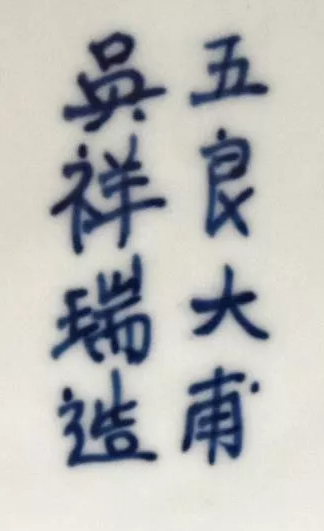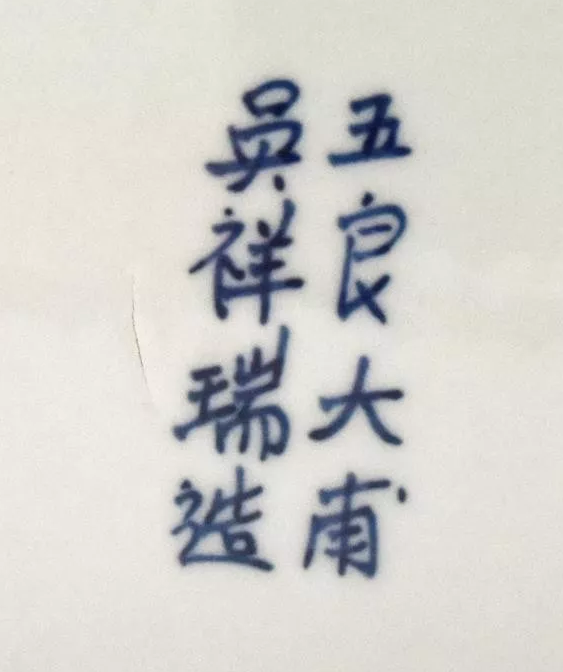瓷器英文名为china,在两千多年前中国瓷器已经向邻国传播,并逐渐成为了与China(中国)密不可分的双关语。作为瓷器故乡的中国不断地向国外输出高端瓷器,但如今我们可以发现,世界顶级的奢侈瓷器牌子都是来自欧洲。
The English name for porcelain is china,. More than two thousand years ago, Chinese porcelain was spread to neighboring countries and gradually became a pun inextricably linked with China (China). As the hometown of porcelain, China continues to export high-end porcelain to foreign countries, but now we can find that the world's top luxury porcelain brands are from Europe.
五良大甫的历史由来:Historical Origin of five Great Fu:在明末崇祯年间,朝廷摇摇欲坠。因国库匮乏,导致景德镇瓷器的制作水平大为退步。但是这时,在景德镇民窑中,一批对日本外销的瓷器却出现了一批署名“五良大甫吴祥瑞造”的青花瓷器,这批瓷器制作极其精良,相比之官窑精品也毫不逊色。当时日本从中国进口的青花瓷被分作“祥瑞”、“染付”、“吴须”三等,祥瑞是其中的上品,而这批瓷器当时也被称为“祥瑞”,可见其精良程度
During the Chong Zhen period in the late Ming Dynasty, the court was teetering. Because of the lack of national treasury, the production level of Jingdezhen porcelain is greatly retrogressed. But at this time, in Jingdezhen folk kiln, a batch of porcelain for export to Japan appeared a batch of blue and white porcelain with the signature "Wu Xiangrui made by Wu Xiangrui". This batch of porcelain is extremely well-made, and compared with the fine articles of official kilns, it is not inferior. At that time, blue and white porcelain imported by Japan from China was classified as "auspicious", "dyed pay", "Wu Shu", and so on. Auspicious luck was one of the best among them, and this batch of porcelain was also called "auspicious" at that time, indicating the degree of sophistication.
五良大甫到底是谁?
Who is five Fu?
五良大甫,其实指的就是日本陶艺家伊滕工郎大夫-伊滕五良大辅。明朝正德年间(1510~1511),他随日本的僧人了庵、桂悟等来到中国景德镇学习制瓷技术 。他在中国学艺五年(亦有史料记载为三年),在此期间他虚心地向有经验的师傅、工匠们请教、取经。在师傅们的传授和指导下,经过不懈努力,终于学会了全套的制瓷技术,并在中国景德镇亲手制作了上万件瓷品,于正德十年(1515年)回国(亦有说正德八年,即1513年)。同时带回去了大量的中国瓷土和釉料,在日本肥前的伊万里开窑,把中国的青花制瓷技术带到了日本,开始了日本青花瓷器的制作年代。为日本民族制瓷事业的发展做出了重大的贡献,被日本人民尊称为“瓷圣”。
Five Fu, actually refers to Japanese ceramic artist Dr. Iraq-Iraq Teng Wuliang big assistant. Ming Dynasty between Ming Dynasty (1510 ~ 1511), he followed Japanese monks Temple, Gui Ming etc. came to China Jingdezhen learn porcelain technology. He studied in China for five years (also recorded as three years) during which he humbly asked experienced teachers craftsmen consult and learn from them.Under teachers' instruction and guidance, after unremitting efforts, finally learned how to porcelain technology, and made thousands of porcelain products in Jingdezhen, China, ten years (1515) returned home (also said Tak eight years, 1513). Meanwhile, we brought back lots of porcelain clay and glaze in china, opened kiln before fat Japanese, brought china blue and white porcelain technology to japan, began making japan blue and white porcelain manufacture ages. Japan has made great contributions to the development of Japanese porcelain industry and was called "porcelain saint" by Japanese people.
“五良大甫吴祥瑞造”是从何而来?
Where did five Great Fu come from?
据考证,这是日本瓷商为了纪念日本“瓷圣”-伊滕工郎大夫·伊滕五良大辅先生,于明末崇祯年间,在景德镇找到了最好的民窑,此人叫吴祥瑞,定制瓷器的时候就署上“五良大甫吴祥瑞造”款,也就是如今这个底款的雏形。从此五良大甫瓷器名扬天下,成为400年来后世仿造的最多的民窑,直到今天还有不少工匠仿造五良大甫的瓷器,当然其中也不乏精品。
According to textual research, this is Japanese porcelain merchant to commemorate Japan "porcelain saint"-Dr. Yi, in late Ming Dynasty Emperor Ming Dynasty, found the best people kiln, this person called Wu Xiangrui, Custom porcelain when the department on "five good Fu built", which is now the rudiment of this bottom.

“五良大甫 吴祥瑞造”款识的青花瓷器,制作极其精良。其复杂精湛的工艺,新颖实用的造型,清新雅致的青花,和独特而多变的图案、纹饰,深得日本人民的喜爱。被日本称作为“祥瑞”或“祥瑞手。只可惜这些瓷器精品大都销往国外,国内极其少见。五良大甫吴祥瑞的故事是中日两国人民友好往来的历史见证。
"five Great Fu Liang built" blue and white porcelain, made extremely sophisticated. Its sophisticated craft novel practical modeling fresh elegant blue and white porcelain and unique changeable patterns and decorative patterns are deeply loved by Japanese people. Known as "auspicious sign" or "auspicious hand" by Japan. Unfortunately, these porcelain products are mostly exported abroad, extremely rare in China. The story of five Great Fu is a historical witness to friendly exchanges between China and Japan.
藏品名称:青花灯笼尊 清代 口径:12.1cm 高度:20cm 底径:11cm
Collection name: blue and white lanterns Zun Qing caliber: 12.1cm height: 20cm bottom diameter: 11cm
此件“五良大甫吴祥瑞造”款的青花灯笼尊非常漂亮精致。瓷器的胎质细白,器形规整,釉层亮丽,青花发色优美,图案内容变化繁多,自古就倍受称道。纹饰表现出强烈的日本式的审美特色。器物的口沿、近底部常围以七宝系、石叠纹、几何纹等装饰纹样;主体部分的图案常为花鸟、山水人物、诗文等。其题款有“五良大甫吴祥瑞造”的铭款。
This blue and white lantern made by Wu Xiangrui of Wu Xiangrui is very beautiful and exquisite.Porcelain's fine white body, regular shape, glaze layer beautiful, beautiful blue and white hair, the content of a wide variety of patterns, much praise since ancient times. The ornamentation shows strong aesthetic characteristics of Japanese style. The mouth edge and near the bottom of the utensils are often surrounded by decorative patterns such as Qibao series, stone stacked patterns, geometric patterns, etc.; the main part of the design is often flowers and birds, landscape figures, poetry and prose, and so on. The inscription is "Wu Xiangrui made by Wu Xiangrui," the inscription of Wu Xiangrui.
藏品名称:青花笔筒 清代 口径:12.5cm 高度:13.5cm 底径:11.5cm
Collection name: blue and white pen container caliber: 12.5cm height: 13.5cm bottom diameter: 11.5cm
此件青花笔筒有“文房四宝”称谓,自古以来就是中国古代最重要的文房用具之一,它既可供使用,又可作观赏,因而书房的陈设高雅便成为品评文采的标准之一,各种式样精美的笔筒应运而生,许多供皇室御用的笔筒,成为中国历代工艺品宝库中的精品。笔筒自明代开始历经多年的发展,经过能工巧匠的设计加工,材质多样、雕镌精致的笔筒至今盛而不衰。现如今,笔筒俨然已经成为中国传统文化的重要符号,因而其市场价值、收藏价值都相对比较高,因此也受到藏家们的喜爱。
This blue and white brush container has the title of "four treasures of the study", and it has been one of the most important study utensils in ancient China since ancient times. It can be used as well as ornamental, so the decorous furnishings of the study have become one of the standards for the evaluation of literary grace.All kinds of exquisite style pen container arises at the historic moment, many for royal family's pen container, becomes in the Chinese successive dynasties handicraft treasure house in the fine goods. Pen container since the Ming Dynasty after many years of development, after skillful craftsman design and processing, material diversity, engraved on the fine pen container is still prosperous and unfailing.Nowadays, pen container has become an important symbol of Chinese traditional culture, so its market value and collection value are relatively high, so it is also loved by collectors.
明正德初年,日本遣使了庵、桂梧等起程来中国景德镇。日本伊势松板人日本陶艺家伊藤五郎大夫(伊藤五良辅)随来(1511年),到中国后还给自己取了个中国的名字——“吴祥瑞”,大概是取其吉祥和瑞气之意。五良大甫在景德镇整整五年,学到了先进的制瓷技术,两年后回国,称“伊藤五郎大夫祥瑞”,以示对中国的怀念,他在日本肥前的伊万里开窑,称伊万里窑,是日本陶瓷发展史上的重要瓷窑之一。他重点学习制造“素肌玉骨”的青花瓷,其青花笔画纯熟,从构图布局、画线、分色整个过程往往一气呵成。笔下的山水、人物、花鸟都是唯取其神态,于熟练中自求变化,形成青花瓷十分明显的特征,伊万里窑生产的青花瓷器大多供日本天皇和皇室贵族使用,因为当时烧制青花瓷器的青料非常昂贵。一般的平民百姓是无法享用的。
Ming Zhengde early years, the Japanese sent a Ambassador, Gui Wu, such as departure to China Jingdezhen. Ise Matsuji Japanese ceramic artist Dr. Ito Goro (Ito Wusuke) came with him (1511), and after he came to China, he gave himself a Chinese name, "Wu Xiangrui," probably because of his auspiciousness and auspiciousness.Wu Liang spent five years in Jingdezhen and learned advanced porcelain technology. Two years later, when he returned home, he called himself "Dr. Ito Goro," to show his nostalgia for China. He opened a kiln in Iwanli, Japan's fat town, and called it the Iwanli Kiln. It is one of the important porcelain kilns in the history of Japanese ceramics development. He focuses on the manufacture of "Suji Yugu" blue and white porcelain, its blue and white brush painting proficiency, from the composition of the layout, drawing lines, color separation of the whole process is often in one go. The landscapes, figures, flowers and birds in the works are all based on their expression, and change themselves in proficiency, forming a very obvious feature of blue and white porcelain. Most of the blue and white porcelain produced by Iwanli kiln are used by the Japanese emperor and the royal nobility.Because the green materials used to make blue and white porcelain were very expensive at that time.It's out of the reach of the average citizen.
以上所展示的青花灯笼尊、青花笔筒参加明年新加坡春季拍卖会,藏品实物经专家老师审核为到代真品。五良大甫吴祥瑞造瓷器胎质细白,器型规整,釉层亮丽;青花发色优美,图案内容变化繁多,瓷品重视内在的高雅,甚于外表的装饰。藏品实物现在深圳市臻藏天下文化艺术品展览有限公司,感兴趣的藏家可到公司鉴赏实物,公司出手快速有保障。
The blue and white lantern respect and blue and white pen container displayed above will attend next year's Singapore spring auction, and the real objects of the collection will be verified by the experts and teachers as the real works on behalf of the artists. Wu Xiangrui, made porcelain with fine white body, regular shape, bright glaze layer, beautiful blue and white hair color, various patterns, and porcelain products that paid more attention to the inherent elegance than the outward decoration. Now Shenzhen ZhenCang world culture and art exhibition co., Ltd., interested collectors can go to the company to appreciate the object, the company moves quickly and securely




